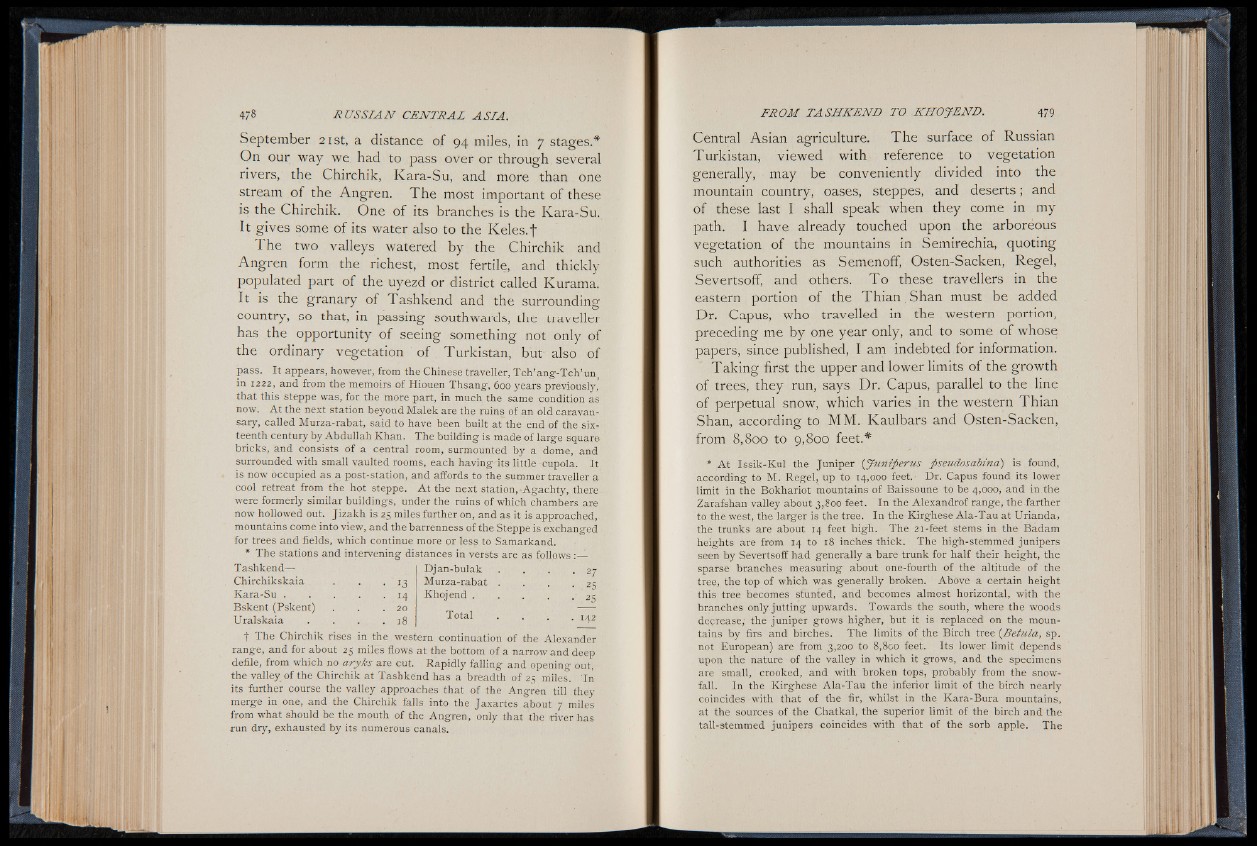
September 21st, a distance of 94 miles, in 7 stages.*
On our way we had to pass over or through several
rivers, the Chirchik, Kara-Su, and more than one
stream of the Angren. The most important of these
is the Chirchik. One of its branches is the Kara-Su.
It gives some of its water also to the K e les .f
The two valleys watered by the Chirchik and
Angren form the richest, most fertile, and thickly
populated part of the uyezd or district called Kurama.
It is the granary of Tashkend and the surrounding
country, so that, in passing southwards, the traveller
has the opportunity of seeing something not only of
the ordinary vegetation of Turkistan, but also of
pass. It appears, however, from the Chinese traveller, Tch’ ang-Tch’un
in 1222, and from the memoirs of Hiouen Thsang, 600 years previously’
that this steppe was, for the more part, in much the same condition as
now. A t the next station beyond M alek are the ruins of an old caravansary,
called Murza-rabat, said to have been built at the end of the sixteenth
century by Abdullah Khan. The building is made of large square
bricks, and consists o f a central room, surmounted by a dome, and
surrounded with small vaulted rooms, each having its little -cupola. It
is now occupied as a post-station, and affords to the summer traveller a
cool retreat from the hot steppe. A t the next station,-Agachty, there-
were formerly similar buildings, under the ruins of which chambers are
now hollowed out. Jizakh is 25 miles further on, and as it is approached,
mountains come into view, and the barrenness of the Steppe is exchanged
for trees and fields, which continue more or less to Samarkand.
* The stations and intervening distances in versts are as follows
Tashkend—
Djan-bulak . . . . 2 7
Chirchikskaia . . . 1 3
Murza-rabat . . . . 2 5
Kara-Su . . . . . 1 4
K h o je n d ...........................................23
Bskent (Pskent) . . . 2 0
Uralskaia . . . . . 1 Total . . . . 142
t The Chirchik rises in the western continuation of the Alexander
range, and for about 25 miles flows at the bottom of a narrow and deep
defile, from which no aryks are cut. Rapidly falling and opening out,
the v a lle y o f the Chirchik at Tashkend has a breadth of 23 miles. 'In
its further course the valley approaches that of the Angren till they
merge in one, and the Chirchik falls into the Jaxartes about 7 miles
from what should be the mouth of the Angren, only that the river has
run dry, exhausted by its numerous canals.
Central Asian agriculture. The surface of Russian
Turkistan, viewed with reference to vegetation
generally, may be conveniently divided into the
mountain country, oases, steppes, and deserts; and
of these last I shall speak when they come in my
path. I have already touched upon the arboreous
vegetation of the mountains in Semirechia, quoting
such authorities as Semenoff, Osten-Sacken, Regel,
Severtsoff, and others. To these travellers in the
eastern portion of the T h ian . Shan must be added
Dr. Capus, who travelled in the western portion,
preceding me by one year only, and to some of whose
papers, since published, I am indebted for information.
Taking first the upper and lower limits of the growth
of trees, they run, says Dr. Capus, parallel to the line
of perpetual snow, which varies in the western Thian
Shan, according to MM. Kaulbars and Osten-Sacken,
from 8,800 to 9,800 feet.*
* A t Issik-Kul the Juniper {Junij>erus Jseudosabina) is found,
according to M. Regel, up to- 14,000 feet. Dr. Capus found its lower
limit in the Bokhariot mountains of Baissoune to be 4,000, and in the
Zarafshan valley about 3,800 feet. In the Alexandrof range, the farther
to the west, the larger is the tree. In the Kirghese Ala-Tau at Urianda,
the trunks are about 14 feet high. The 21-feet stems in the Badam
heights are from 14 to 18 inches thick. The high-stemmed junipers
seen by Severtsoff had generally a bare trunk for half their height, the
sparse branches measuring about one-fourth of the altitude of the
tree, the top of which was generally broken. Above a certain height
this tree becomes stunted, and becomes almost horizontal, with the
branches only.jutting upwards. Towards the south, where the woods
decrease; the juniper grows higher, but it is replaced on the mountains
by firs and birches. The limits of the Birch tree (.Betula, sp.
not European) are from 3,200 to 8,8co feet. Its lower limit depends
upon the nature of the valley in which it grows, and the specimens
are small, crooked, and with broken tops, probably from the snowfall.
In the Kirghese Ala-Tau the inferior limit of the birch nearly
coincides with that of the fir, whilst in the Kara-Bura mountains,
at the sources of the Chatkal, the superior limit of the birch and the
tall-stemmed junipers coincides with that of the sorb apple. The